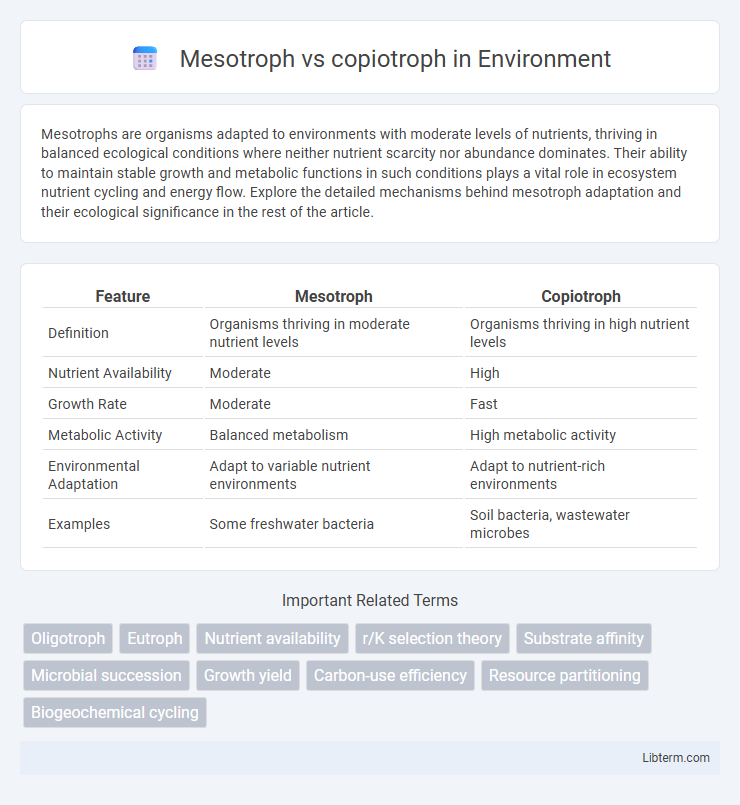Mesotrophs are organisms adapted to environments with moderate levels of nutrients, thriving in balanced ecological conditions where neither nutrient scarcity nor abundance dominates. Their ability to maintain stable growth and metabolic functions in such conditions plays a vital role in ecosystem nutrient cycling and energy flow. Explore the detailed mechanisms behind mesotroph adaptation and their ecological significance in the rest of the article.
Table of Comparison
| Feature | Mesotroph | Copiotroph |
|---|---|---|
| Definition | Organisms thriving in moderate nutrient levels | Organisms thriving in high nutrient levels |
| Nutrient Availability | Moderate | High |
| Growth Rate | Moderate | Fast |
| Metabolic Activity | Balanced metabolism | High metabolic activity |
| Environmental Adaptation | Adapt to variable nutrient environments | Adapt to nutrient-rich environments |
| Examples | Some freshwater bacteria | Soil bacteria, wastewater microbes |
Introduction to Mesotrophs and Copiotrophs
Mesotrophs are organisms that thrive in environments with moderate nutrient availability, balancing growth rates between oligotrophs and copiotrophs. Copiotrophs, in contrast, rapidly proliferate in nutrient-rich environments, exhibiting high metabolic activity and resource consumption. Understanding the ecological roles and metabolic strategies of mesotrophs and copiotrophs is essential for studying microbial dynamics in diverse ecosystems.
Defining Mesotrophs: Key Characteristics
Mesotrophs thrive in environments with moderate nutrient availability, displaying balanced growth rates between oligotrophs and copiotrophs. They exhibit adaptive metabolic versatility, allowing efficient nutrient utilization under fluctuating conditions. These microbes possess moderate enzyme production and maintain stable cellular functions without requiring nutrient saturation.
Understanding Copiotrophs: Core Features
Copiotrophs thrive in nutrient-rich environments with high organic carbon availability, displaying rapid growth rates and efficient substrate utilization. They possess larger genomes and extensive regulatory networks to quickly adapt to fluctuating resource levels. These bacteria contrast with mesotrophs, which tolerate moderate nutrient conditions but lack the heightened metabolic flexibility and growth efficiency characteristic of copiotrophs.
Mesotrophs vs. Copiotrophs: Nutrient Utilization Strategies
Mesotrophs employ moderate nutrient utilization strategies, thriving in environments with balanced resource availability and efficiently processing organic matter at intermediate rates. Copiotrophs, in contrast, rapidly exploit nutrient-rich conditions, exhibiting high growth rates and metabolic activity that enable quick adaptation to fluctuating nutrient inputs. This differentiation influences microbial ecosystem dynamics, with mesotrophs maintaining stability in nutrient cycling while copiotrophs respond swiftly to organic enrichment.
Environmental Niches and Habitats
Mesotrophs thrive in environments with moderate nutrient levels, commonly found in soil ecosystems and freshwater habitats where nutrient concentrations fluctuate. Copiotrophs prefer nutrient-rich habitats such as nutrient-loaded waters, composts, and sewage, enabling rapid growth in conditions with abundant organic matter. These differing ecological strategies allow mesotrophs to dominate stable, oligotrophic settings, while copiotrophs exploit transient, nutrient-rich niches.
Microbial Diversity and Community Structure
Mesotrophic environments support a balanced microbial diversity with both mesotrophs and copiotrophs present, influencing community structure through moderate nutrient availability that favors diverse metabolic strategies. Copiotrophs dominate nutrient-rich conditions, rapidly exploiting high resource levels and often leading to reduced microbial diversity due to competitive exclusion. Mesotrophs thrive in environments with intermediate nutrient concentrations, promoting stable microbial communities by maintaining functional redundancy and resilience within the ecosystem.
Metabolic Pathways: Mesotrophs versus Copiotrophs
Mesotrophs primarily utilize versatile metabolic pathways that enable efficient energy extraction from low to moderate nutrient levels, often relying on aerobic respiration and mixed metabolic strategies. Copiotrophs exhibit rapid growth by predominantly employing glycolytic pathways and fermentative metabolism optimized for high nutrient availability, resulting in accelerated biomass synthesis. Differences in metabolic regulation and enzyme expression reflect adaptation to their respective environments, influencing carbon flux and nutrient cycling dynamics.
Ecological Roles and Environmental Impact
Mesotrophs play a crucial role in nutrient cycling within ecosystems by thriving in environments with moderate nutrient levels, contributing to balanced organic matter decomposition and maintaining soil fertility. Copiotrophs dominate nutrient-rich environments, rapidly decomposing organic materials and driving high rates of carbon and nitrogen turnover, often influencing ecosystem productivity and succession dynamics. The ecological impact of copiotrophs includes accelerating nutrient release and supporting fast-growing plant species, while mesotrophs ensure stability in nutrient availability and ecosystem resilience under fluctuating conditions.
Applications in Biotechnology and Environmental Science
Mesotrophs and copiotrophs exhibit distinct metabolic strategies valuable in biotechnology and environmental science; mesotrophs thrive in moderate nutrient conditions, facilitating balanced bioremediation processes, while copiotrophs excel in nutrient-rich environments, enhancing rapid degradation of organic pollutants. The targeted use of copiotrophic bacteria accelerates composting and wastewater treatment by efficiently breaking down high concentrations of organic matter. Mesotrophic organisms support sustainable ecosystem management by maintaining microbial diversity and stability in fluctuating nutrient scenarios crucial for soil health and pollutant mitigation.
Future Research Directions and Challenges
Future research on mesotrophs and copiotrophs should prioritize understanding their adaptive mechanisms to fluctuating nutrient environments using multi-omics approaches. Challenges include deciphering their interactions within complex microbial communities and quantifying their roles in biogeochemical cycles under climate change scenarios. Developing predictive models integrating genomic and environmental data will enhance insights into their ecological functions and responses to anthropogenic impacts.
Mesotroph Infographic

 libterm.com
libterm.com